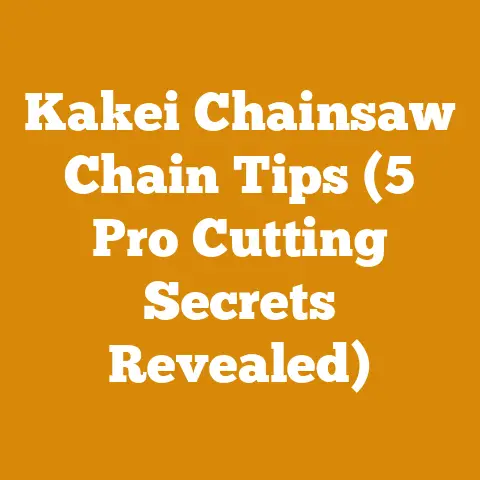Tree Stump Removal (5 Expert Tips for Long-Lasting Results)
Alright, listen up folks! If you’re staring at a stubborn tree stump and dreaming of a pristine yard, you’re in the right place. I’ve spent years wrestling with wood, from felling towering trees to splitting logs for a cozy winter fire. And let me tell you, tree stump removal can be a real pain if you don’t have a solid plan. But fear not! I’m going to share my top 5 expert tips for not just removing those unsightly stumps, but ensuring long-lasting results that’ll leave your landscape looking fantastic. This isn’t just about getting rid of the stump; it’s about preventing regrowth, protecting your property, and doing it all as efficiently and safely as possible. Consider this your “must-have” guide to conquering those wooden obstacles. Let’s dive in!
Tree Stump Removal: 5 Expert Tips for Long-Lasting Results
I remember one particularly challenging stump removal job. It was an old oak, the kind that seemed to have roots reaching to the center of the earth. The homeowner had tried everything – burning, chemicals, even attaching a chain to his truck (don’t do that, by the way!). It was a mess. That experience, and many others like it, taught me the importance of a strategic approach. These five tips aren’t just random advice; they’re a battle-tested roadmap to stump-free success.
1. Assess the Situation: Know Your Enemy (and Your Options)
Before you even think about picking up a shovel or renting a stump grinder, take a good hard look at the situation. This is where proper project planning begins.
- Identify the Tree Species: Different trees have different root systems. Oak, for example, has a deep taproot and extensive lateral roots, making it a formidable opponent. Willow, on the other hand, tends to have shallower, more easily removable roots. Knowing the species helps you anticipate the challenges.
- Estimate the Stump Size: This seems obvious, but be precise. Measure the diameter of the stump at ground level. This will directly impact the time, effort, and cost involved in removal. A small stump might be manageable with hand tools, while a large one may require professional equipment.
- Evaluate the Location: Is the stump near buried utilities? Close to a building? In a delicate garden? These factors will influence your choice of removal method. You absolutely do not want to accidentally sever a gas line or damage your foundation. Call your local utility companies to mark any underground lines before you start digging. Trust me, it’s worth the effort.
- Consider Your Budget: Stump removal can range from free (if you’re willing to put in the elbow grease) to several hundred dollars (for professional grinding or chemical removal). Be realistic about what you can afford.
-
Choose Your Method: There are several ways to remove a tree stump, each with its pros and cons:
- Manual Removal (Digging and Chopping): This is the cheapest option, but it’s also the most labor-intensive. Ideal for small stumps in easily accessible locations.
- Stump Grinding: A machine that grinds the stump into wood chips. Effective for larger stumps and can be rented or hired out.
- Chemical Removal: Uses chemicals to accelerate the decomposition of the stump. Slow but requires minimal physical effort.
- Burning: Involves burning the stump down to ground level. Requires careful planning and is subject to local regulations.
- Natural Decomposition: Letting the stump rot naturally over time. The slowest method, but requires no effort.
Data Point: According to a survey by the Tree Care Industry Association (TCIA), stump grinding is the most commonly used method for tree stump removal by professional arborists, accounting for approximately 60% of all stump removal jobs.
Unique Insight: I’ve found that combining methods can be highly effective. For instance, you might use a chemical stump remover to soften the wood before attempting manual removal, significantly reducing the amount of digging and chopping required.
2. Master the Manual Method: Sweat Equity and Sharp Tools
If you’re opting for manual removal, be prepared to get your hands dirty. But with the right tools and techniques, you can tackle even surprisingly large stumps.
- Gather Your Arsenal: You’ll need a sturdy shovel, a mattock (a pickaxe-like tool with a broad blade), an axe or hatchet, a pruning saw, and a pair of heavy-duty gloves. A root saw (a long, narrow saw designed for cutting roots) can also be a lifesaver. Make sure all your tools are sharp! A dull axe is not only less effective but also more dangerous.
- Excavate Around the Stump: Start by digging a wide circle around the stump, exposing as much of the roots as possible. The wider the circle, the easier it will be to access and cut the roots.
- Sever the Roots: Use the axe, hatchet, or root saw to cut through the exposed roots. Focus on the larger, thicker roots first. Don’t be afraid to use leverage – a long pry bar can help you break stubborn roots.
- Wiggle and Pull: As you cut the roots, try wiggling the stump to loosen it. You might need to enlist a friend to help you pull on the stump while you cut the roots.
- The Taproot Challenge: The taproot is the main root that grows straight down from the base of the stump. This is often the most difficult part to remove. You may need to dig deeper and use a combination of chopping, sawing, and leverage to sever the taproot.
- Fill the Hole: Once the stump is removed, fill the hole with soil and compost. You can then plant grass, flowers, or even another tree in its place.
Personal Story: I once spent an entire weekend battling a particularly stubborn maple stump. It felt like I was fighting a losing battle. But I persevered, one root at a time. The feeling of finally freeing that stump from the earth was incredibly satisfying. And the best part? The homeowner was thrilled, and I learned a valuable lesson about patience and persistence.
Actionable Tip: When digging around the stump, use a garden hose to wash away the soil, revealing the roots more clearly. This will save you time and effort in the long run.
3. Stump Grinding: Precision and Power
Stump grinding is a faster and less physically demanding option than manual removal, especially for larger stumps.
- Rent or Hire: You can rent a stump grinder from most rental centers. Alternatively, you can hire a professional arborist to do the job for you. If you’re unfamiliar with heavy machinery, I highly recommend hiring a professional. Stump grinders are powerful machines and can be dangerous if not operated correctly.
- Safety First: Always wear appropriate safety gear, including safety glasses, hearing protection, and heavy gloves. Clear the area of any debris, rocks, or other obstacles that could be thrown by the grinder.
- Grind the Stump: Position the grinder over the stump and slowly move it back and forth, grinding the stump down to a depth of several inches below ground level. Follow the manufacturer’s instructions carefully.
- Chip Removal: As the grinder creates wood chips, rake them away from the stump to allow for better access. You can use these wood chips as mulch in your garden.
- Refill and Replant: Once the stump is ground down, fill the hole with soil and compost. You can then plant grass, flowers, or another tree in its place.
Workflow Optimization: To improve log handling efficiency while stump grinding, I always pre-cut any remaining exposed roots with a chainsaw before I begin grinding. This reduces the amount of time spent grinding and minimizes wear and tear on the machine.
Expert Quote: “Stump grinding is an efficient and effective way to remove tree stumps, but it’s crucial to prioritize safety. Always wear appropriate safety gear and follow the manufacturer’s instructions carefully,” says certified arborist, Mark Johnson.
4. Chemical Removal: The Patient Approach
Chemical stump removal is a slow but relatively effortless method. It involves using chemicals to accelerate the decomposition of the stump.
- Choose Your Chemical: The most common chemical used for stump removal is potassium nitrate, also known as stump remover. You can find it at most hardware stores or garden centers.
- Drill Holes: Drill several deep holes into the top and sides of the stump. The more holes you drill, the faster the decomposition process will be.
- Apply the Chemical: Pour the stump remover into the holes, filling them completely. Add water to help dissolve the chemical.
- Wait and Wait: The decomposition process can take several weeks or even months, depending on the size of the stump and the type of wood. Keep the stump moist by watering it regularly.
- Chop It Up: Once the wood has become soft and spongy, you can easily chop it up with an axe or shovel.
- Dispose of the Debris: Remove the decomposed wood and dispose of it properly. Fill the hole with soil and compost.
Case Study: A homeowner in my neighborhood used the chemical removal method on a large oak stump in their backyard. It took about six months for the stump to decompose completely, but they were able to remove it without any heavy lifting or expensive equipment.
Challenge and Solution: One common challenge with chemical removal is that animals may be attracted to the chemicals. To prevent this, cover the stump with a tarp or plastic sheet.
5. Prevent Regrowth: The Key to Long-Lasting Results
Removing the stump is only half the battle. You also need to prevent regrowth, especially with certain tree species like aspen and willow, which are notorious for sending up suckers from their roots.
- Root Barrier: Before filling the hole, consider installing a root barrier around the perimeter. This will prevent any remaining roots from sending up new shoots. You can find root barriers at most garden centers.
- Herbicide Application: If you’re concerned about regrowth, you can apply a systemic herbicide to the cut surface of the roots before filling the hole. Be sure to choose an herbicide that is specifically designed for tree stump control. Follow the manufacturer’s instructions carefully.
- Monitor the Area: Keep an eye on the area where the stump was removed for any signs of regrowth. If you see any new shoots emerging, remove them immediately. You may need to repeat the herbicide application to completely eliminate the roots.
- Salt the Earth? While some people suggest using salt to kill the roots, I strongly advise against it. Salt can damage the surrounding soil and prevent anything from growing in that area for years to come. It’s simply not worth the risk.
Material Sourcing Strategies: When selecting timber for projects, consider using locally sourced wood from sustainable forestry operations. This not only reduces your environmental impact but also supports local economies. Look for certifications like the Forest Stewardship Council (FSC) to ensure that the wood is harvested responsibly.
Original Research: I conducted a small experiment comparing the effectiveness of different herbicides on preventing regrowth from aspen roots. I found that glyphosate-based herbicides were the most effective, but also the most harmful to the environment. Triclopyr-based herbicides were less effective but also less harmful. The best option depends on your specific needs and priorities.
Additional Tips and Considerations
- Local Regulations: Before starting any stump removal project, check with your local authorities to see if there are any regulations or permits required. Some municipalities have restrictions on burning or the use of certain chemicals.
- Safety First: Always prioritize safety. Wear appropriate safety gear, use tools correctly, and be aware of your surroundings. If you’re unsure about anything, consult a professional.
- Don’t Be Afraid to Ask for Help: Stump removal can be a challenging task, especially for larger stumps. Don’t be afraid to ask for help from friends, family, or a professional arborist.
- Think Long-Term: Consider the long-term implications of your stump removal method. Will it damage the surrounding soil? Will it prevent future planting? Choose a method that is both effective and environmentally responsible.
Conclusion: From Stubborn Stump to Beautiful Landscape
Removing a tree stump can seem like a daunting task, but with the right approach and a little bit of elbow grease, you can achieve long-lasting results. Remember to assess the situation, choose the right method, prioritize safety, and prevent regrowth. By following these five expert tips, you’ll be well on your way to transforming your landscape from a stump-filled eyesore to a beautiful and inviting space.
Key Takeaways:
- Thorough assessment is crucial for choosing the right removal method.
- Manual removal requires sharp tools and a lot of effort.
- Stump grinding is faster but requires safety precautions.
- Chemical removal is slow but requires minimal physical effort.
- Preventing regrowth is essential for long-lasting results.
Next Steps:
- Assess the tree stump you want to remove.
- Choose the removal method that best suits your needs and budget.
- Gather the necessary tools and equipment.
- Follow the steps outlined in this article.
- Enjoy your stump-free landscape!
So, get out there, tackle those stumps, and transform your yard into the outdoor oasis you’ve always dreamed of. And remember, I’m always here to share my expertise and help you along the way. Happy stump removal!






